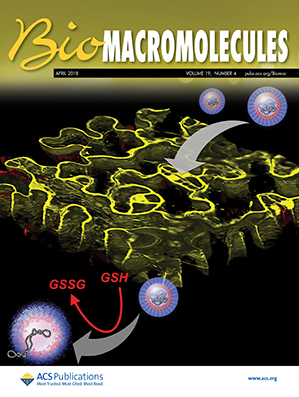海藻糖释放纳米凝胶:海藻糖释放的研究和对选定生物学相关方面的见解。
IF 5.4
2区 化学
Q1 BIOCHEMISTRY & MOLECULAR BIOLOGY
引用次数: 0
摘要
海藻糖已经引起了相当大的兴趣,在各种医药应用以及在冷冻保存。近年来,为了解决海藻糖生物利用度差的问题,人们越来越多地致力于开发海藻糖纳米载体。大多数策略包括海藻糖的物理捕获,因为它的共价,但生物稳定性,偶联是具有挑战性的。在这里,我们介绍了海藻糖释放纳米凝胶的研究,其中海藻糖(甲基)丙烯酸酯(s)与亲水性的一级/二级丙烯酰胺在一个聚合物网络中共掺入,实现了海藻糖的共价,但生物稳定的偶联。在这种情况下,一级和二级酰胺基团参与了(甲基)丙烯酸酯单元的酯水解,使得在生理相关条件下水解是可行的。合成并表征了一组精确选择组成的纳米凝胶,并研究了各种结构和环境因素对海藻糖释放速率的影响。该研究还为潜在的生物医学应用提供了一些重要的其他方面的见解,包括纳米凝胶通过其末端α-d-葡萄糖吡喃基部分从垂坠海藻糖,蛋白质冠形成和细胞摄取的特定相互作用。本文章由计算机程序翻译,如有差异,请以英文原文为准。
Trehalose-Releasing Nanogels: Study on Trehalose Release and Insights into Selected Biologically Relevant Aspects
Trehalose has sparked considerable interest in a variety of pharmaceutical applications as well as in cryopreservation. Recently, there have been growing efforts in the development of trehalose delivery nanocarriers to address the issue of the poor bioavailability of trehalose. The majority of the strategies comprise physical entrapment of trehalose, since its covalent, yet biolabile, conjugation is challenging. Here, we present research on trehalose-releasing nanogels, in which covalent, yet biolabile, conjugation of trehalose was achieved through the co-incorporation of trehalose (meth)acrylate(s) together with hydrophilic primary/secondary acrylamides in one polymeric network. In this case, the primary and secondary amide groups participated in ester hydrolysis in the (meth)acrylate units, making the hydrolysis feasible under physiologically relevant conditions. A set of nanogels with precisely selected compositions were synthesized, characterized, and then studied to evaluate the influence of various structural and environmental factors on the release rate of trehalose. The study also provides insights into some other aspects that are important in view of potential biomedical applications, including specific interactions of nanogels through their terminal α-d-glucopyranosyl moieties from pendant trehalose, protein corona formation, and cellular uptake.
- Download: Download high-res image (135KB)
- Download: Download full-size image
求助全文
通过发布文献求助,成功后即可免费获取论文全文。
去求助
来源期刊

Biomacromolecules
化学-高分子科学
CiteScore
10.60
自引率
4.80%
发文量
417
审稿时长
1.6 months
期刊介绍:
Biomacromolecules is a leading forum for the dissemination of cutting-edge research at the interface of polymer science and biology. Submissions to Biomacromolecules should contain strong elements of innovation in terms of macromolecular design, synthesis and characterization, or in the application of polymer materials to biology and medicine.
Topics covered by Biomacromolecules include, but are not exclusively limited to: sustainable polymers, polymers based on natural and renewable resources, degradable polymers, polymer conjugates, polymeric drugs, polymers in biocatalysis, biomacromolecular assembly, biomimetic polymers, polymer-biomineral hybrids, biomimetic-polymer processing, polymer recycling, bioactive polymer surfaces, original polymer design for biomedical applications such as immunotherapy, drug delivery, gene delivery, antimicrobial applications, diagnostic imaging and biosensing, polymers in tissue engineering and regenerative medicine, polymeric scaffolds and hydrogels for cell culture and delivery.
 求助内容:
求助内容: 应助结果提醒方式:
应助结果提醒方式:


